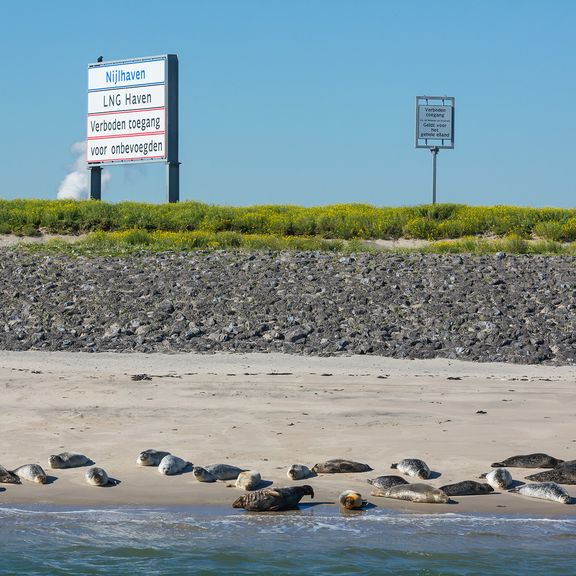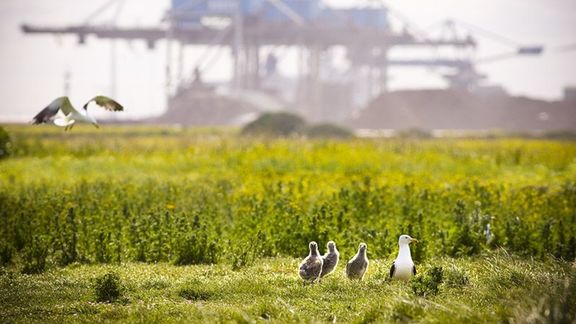
Nature and biodiversity in the ports
Economic progress is important but may never be at the expense of nature, the environment, and the living environment of the port industrial area. The port of Rotterdam is a place of industry as well as of nature. The Port Authority is careful about nature and biodiversity in and around the port area and devotes itself actively to conserving nature and helping it develop.
Nature Vision
Therefore, in line with the Port Vision 2030, we developed our own Nature Vision. With the Nature Vision we integrate nature into our plans and projects. This is how we increase biodiversity in the port area.

Discover nature in the port
It is surprising how much nature the port of Rotterdam has to offer, like the nature on Landtong Rozenburg, for instance, the Bird Valley, Geuzenbos, or tide park Groene Poort but also at unexpected locations right in the midst of industry. From oysters to orchids. Seals and pipistrelle bats can also be found in the area. Free-roaming Highland and tauros cattle help with the natural management of a number of areas. You can even discover protected species there, such as the natterjack toad and the fen orchid.
Important ecosystem
The port of Rotterdam offers many hectares of nature and is an important ecosystem with over 200 unique plant and animal species. When developing the port, careful consideration must be given to protected plant and animal species, nature values and biodiversity. This requires expert management and considered choices. When developing port areas or building infrastructure, we take into account the quality of the living environment, design with nature in mind (nature inclusive) and prevent and, where necessary, compensate damage to protected nature. The nature guide shows where these species occur in the port area.
Surface area of nature in the port
| Surface area | Nature |
|---|---|
| 9,900,000 m2 Grassy vegetation | Cable and pipe strips, roadsides and other areas with grasses, herbs and wildflowers |
| 780,000 m2 Naturally managed areas | Bird Valley, Botlekbos, Geuzenbos, nature on Landtong Rozenburg |
| 40,000 m2 Ecological stepping stones | Nature areas in the port area that foster connection with nature: Crab Land and Little Bear Island |
| 11,036 Trees | Various species of trees |
| 598,000 m2 Open watercourses | Ditches, water bodies in the port area |
| 191,000 m2 Slopes | Transitions to open sea, influenced by the tide |
| 7,400,000 m2 Developable land | Fallow land where nature has free reign |
Port of Rotterdam Authority realises its own tree nursery in the port
The Port Authority has a tree nursery at Rhoonsedijk in the Eemhaven. It is here that we grow trees for our own use. This allows us to increase biodiversity by providing more space to birds and insects. On 15 March 2023, during the closing of the Tree Festival season, children from the Don Bosco school, together with the Rotterdam branch of idverde Realisatie, and the city forester planted around 500 trees. When the trees are large enough, the Port Authority will use them to replace other trees or create new areas. The planting of these trees is in line with our policy to increase biodiversity in the port, make the port more sustainable and retain its appeal.
Nature-friendly management
In the port area, we apply ecological management, seeking to achieve a healthy balance between plants, humans and animals. We do this by seeing to it that the habitat for crucial species is safeguarded, that problem species are controlled, and that protected and threatened flora and fauna on land and under water are monitored.
WILD PORT OF EUROPE
The ports of Rotterdam and Moerdijk will not be at the front of your mind when you think about nature. Yet, these industrialised areas inspired the makers of Wild Port of Europe to make a film about the resilience of nature.
Problem species prevention
Exotic or foreign species are plants or animals which are taken outside their original and natural habitat. By their mere presence, some species, like the Japanese Persicaria, are a threat to the population of native species, or they damage constructions and paving. The Port Authority does its utmost to keep problem species under control to restore the natural ecosystem.
Connecting nature
The geographical location of the port in a river delta on the coast makes the port the perfect biotope for pioneers and coast-bound species, such as waders, natterjack toads, various orchids, and migratory fish, like eel and salmon. These plants and animals quickly spread from one area to another. ‘Ecological stepping-stones’ have been constructed at strategic locations in the port. Via these locations, like verges, pipeline corridors, and sites not yet issued, plants and animals can move.